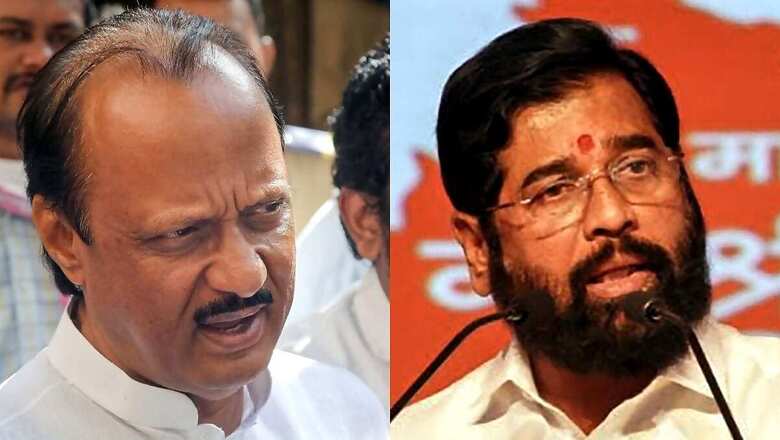
views
After vertical splits in the Shiv Sena and the NCP, the BJP-led NDA in Maharashtra now has 185 MLAs. The Bharatiya Janata Party has 105 MLAs, the Eknath Shinde-led Shiv Sena has 40, and Ajit Pawar’s Nationalist Congress Party camp avowedly has 40 as well.
Now the big question is, can it solve the BJP’s arithmetic for the upcoming Lok Sabha elections likely in April-May 2024?
The BJP and the undivided Shiv Sena fought the 2019 Lok Sabha elections in an alliance, winning 41 seats out of the 48 in the state. The BJP won 23 and the Shiv Sena 18. They fought the next assembly elections in October 2019 in a coalition as well, bagging 161 seats. The BJP netted 105 seats with a 25.75% vote share. The Shiv Sena was the second-largest party with 56 seats and a 16.41% vote share. It was 16 more than the majority mark in the 288-member Maharashtra assembly. Following the poll results, the parties parted ways over a power-sharing disagreement.
The BJP did try to take power with Ajit Pawar’s rebellion in the NCP in November 2019. But the government could survive just for three days as other NCP MLAs decided not to support Ajit Pawar then.
Later, the Shiv Sena allied with the Congress and the NCP to form a government in the state with Uddhav Thackeray as the chief minister. The alliance called Maha Vikas Aghadi (MVA) had 154 seats and a 48.99% vote share. Ajit Pawar returned to the NCP fold and was made deputy chief minister.
It looked like a formidable political alliance that could have made the BJP’s political journey ahead in Maharashtra difficult. With three other big parties and their vote bank together, the BJP was looking at the possibility of getting its gains in the state’s politics, of being the largest party in the Lok Sabha polls and assembly polls, being dented. The Congress-NCP alliance had ruled the state for three consecutive terms, from 1999 to 2014, and could still have been a poll behemoth. The addition of the Shiv Sena, a party strong in the Mumbai-Konkan region and a former BJP ally, looked like an added advantage to push more voters to its side.
The year 2022 gave the BJP a way out of this political crisis with the Shiv Sena rebellion. The MVA government came down in June last year after a revolt by 40 Shiv Sena MLAs under Eknath Shinde on the issue of Hindutva and an inclination to align with the BJP. The BJP and Shiv Sena (Eknath Shinde) camp formed the government in July 2022.
SHIV SENA SPLIT WAS BJP’S FIRST MAJOR SUCCESS
With the Shiv Sena being a core Hindutva party, the rebelling MLAs were not comfortable with the MVA’s ideology and political style. “Secular” politics is central to the Congress and NCP, which the Shiv Sena had asked to be removed from the Indian Constitution in the past. The rebelling MLAs decided to align with the BJP to form the government. Shinde was chosen as the chief minister.
The Shiv Sena was split into two, with the rebel faction given the party name and the election symbol later by the Election Commission. Theoretically, with this coalition, the BJP was again back at the top with a 42.16% vote share, though with 16 fewer seats than the 2019 tally, at 145. The alliance government got support from others, winning the trust vote with a tally of 164.
The Shiv Sena is considered influential in Mumbai and Konkan regions and a dominant political force in Mumbai, Thane, and Kalyan. The Maratha community, Hindutva followers, and urban middle class are seen as its core supporters. The BJP has bet big on Eknath Shinde with 39 MLAs, 12 MPs, and a part of the Shiv Sena organisational structure coming with him.
Only an electoral outcome can prove the validity of this idea, but Shinde is seen as a strong leader in the Thane and Kalyan-Dombivli municipal regions with many corporators and party workers supporting him. That goes with the fact that Uddhav Thackeray is not Bal Thackeray, the Shiv Sena founder and a pillar of Maharashtra’s politics.
Bal Thackeray had a massive appeal while Uddhav’s push could not save the party from losing the Bandra East assembly seat in the 2019 elections. The Thackeray family residence Matoshree is in Bandra East, and the area is seen as its home turf. Also, the losing Shiv Sena candidate, Vishwanath Mahadeshwar, was the BMC mayor as well. Uddhav Thackeray’s appeal to voters failed with party MLA Trupti Sawant turning rebel and contesting as an independent candidate. The Congress won the seat.
Eknath Shinde took away with himself 70% of the Shiv Sena candidates, or almost 12% of the 16.41% votes the party got in the assembly polls. The BJP would try to maximise on this electoral arithmetic in the 2024 Lok Sabha elections.
AJIT PAWAR’S RETURN COMPLETES THE GAME
Exactly a year after Eknath Shinde’s moment, the NDA government has been joined by rebelling NCP MLAs under the leadership of Ajit Pawar. Sharad Pawar’s nephew was the leader of the opposition in the state assembly. Ajit claims he has the support of 40 MLAs of the party and stakes claim to the NCP’s name and symbol, much like the Shiv Sena rebel faction.
Ajit Pawar and many NCP MLAs were looking to join the BJP right from the 2019 elections as was clear with his previous rebellion. They did not have the numbers then that they claim to have now, with many big NCP leaders like Praful Patel, Chhagan Bhujbal, Dilip Walse Patil, Hasan Mushrif, and Dhananjay Munde joining his camp. Also, prior to making this rebellion open, the Ajit Pawar camp moved to the Election Commission, with affidavits of 40 NCP MPs, MLAs, and MLCs, declaring he was elected president of the party on June 30. His faction has also staked claim to the party’s name and electoral symbol.
Now the big question is how much help the Ajit Pawar faction can give to the overall NDA in the Lok Sabha polls as Sharad Pawar is still one of the towering personalities in Maharashtra politics and the NCP’s political existence is still associated with his name.
The Maratha community and Muslims are seen as the NCP’s core supporters. Western Maharashtra and particularly the Pune district are considered its bastions. Its largest vote share comes from districts like Pune, Satara, Sangli, Kolhapur, and Solapur, also known as the Maharashtra sugar belt. The region is dominated by the Maratha community. Western Maharashtra accounts for 10 Lok Sabha and 60 assembly seats. The NCP won 19 assembly seats from this region in 2014 and 27 seats in the 2019 assembly elections.
Overall, the party won 54 seats in the 2019 assembly polls with a 16.71% vote share, and it will be Ajit Pawar and the rebelling faction’s big test if they can politically survive outside and match or better the 2019 performance with Sharad Pawar being their rival now. The 2024 Lok Sabha elections will be a big challenge for both Pawar groups, Sharad and Ajit, to appeal to and woo the Maratha voters. The BJP’s election arithmetic for the Lok Sabha polls needs Ajit Pawar’s faction to have its own political base.
OPPOSITION IN DISARRAY
The winding and unwinding of the MVA in just 31 months have given the BJP an electoral platform to leverage ahead. Not much time is left for the Lok Sabha elections and the opposition vote bank in the state is in complete disarray, witnessing two big vertical splits in two years. With the effectiveness of the MVA in question, voters can face a dilemma on whom to support in the polls.
Uddhav Thackeray has lost his battle for reinstatement in the Supreme Court while the NCP speaks in two voices on legal options. Sharad Pawar says “no”, while his party’s state president says that “we are exploring legal options”. What if the Congress follows suit with factionalism running high in the party? In February, senior leader and ex-minister Balasaheb Thorat resigned as the legislative party leader, blaming state unit president Nana Patole. His resignation was not accepted but it once again laid bare chinks in the party’s state leadership.
Two parties of the MVA are facing an existential crisis and the chances of the third are not good either, say observers. The opposition space in Maharashtra politics is staring at a dark future and it is only expected to help the BJP.


















Comments
0 comment